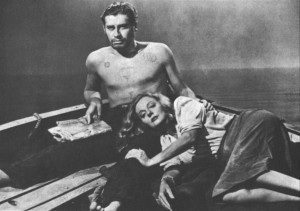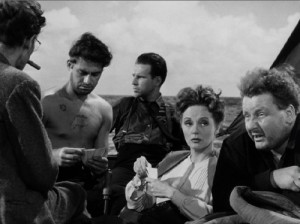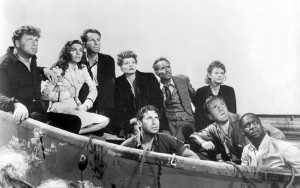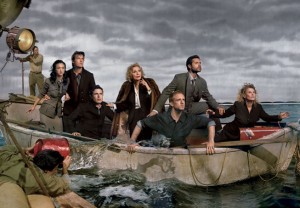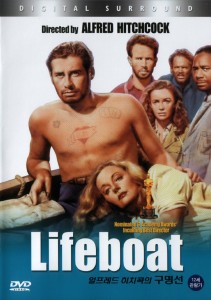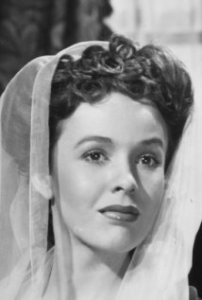Lifeboat **** (1944, Tallulah Bankhead, William Bendix, Walter Slezak, Mary Anderson, John Hodiak) – Classic Movie Review 273
Alfred Hitchcock said of his 1944 wartime thriller film Lifeboat: ‘I never let that camera get outside the lifeboat. The technical challenge was enormous. Of course Tallulah Bankhead dominated the whole film.’
Alfred Hitchcock’s 1944 self-imposed challenge in limiting himself to making a movie with a tiny group of people and restricting himself to a single miniscule setting of a tiny boat proves a remarkable success. Thus inspired, he somehow manages to stir up his customary suspense and tension, and turn a talk-propelled, issue-led and character-driven drama into a proper thriller too.
In the Atlantic during World War Two, a German U-boat engages a passenger ship in a battle and shoots it out of the sea. The small handful of survivors gathers together in a lifeboat to seek to set sail for survival and safety. They include an international journalist, a rich businessman, the radio operator, a nurse, a steward, a sailor and a communist-sympathising engineer.
Adding to their desperate problems, a man they pull out of the water turns out to be the Nazi captain (Walter Slezak) of the U-boat, prompting much soul searching. He seems a pretty good candidate for tipping overboard.
This wartime ‘ship of fools’ story is boosted by excellent playing from the seemingly eccentrically assorted cast of notables, especially Tallulah Bankhead as Connie Porter, a fashion writer desperately clinging to her typewriter and jewellery.
Hitchcock knows he’s got to pull the rabbit out the hat and is inspired to come up with the kind virtuoso direction that not only makes it work but also makes it memorable.
Henry Hull, John Hodiak, Canada Lee, William Bendix, Mary Anderson, Heather Angel and Hume Cronyn are also the other notables in the small cast. But, acting-wise, the film belongs to Bankhead. This is an excellent showcase for an over-large personality that rarely worked as well as this in the movies. However, Slezak, Bendix and Cronyn find some space to shine, too.
Otherwise, of course, the film belongs to Hitchcock, who makes his customary appearance in in the before and after pictures a slimming ad for imaginary drug Reduco Obesity Slayer on a newspaper passing by the lifeboat (‘that’s my favourite role and I must admit I had an awful time thinking it up’). He made cameo appearances in 39 of his 52 surviving major films (his second film The Mountain Eagle is lost). He appears in all his 30 features from his first American film Rebecca onwards.
Hitchcock said he was besieged by letters from people inquiring about Reduco, which he uses again in Rope, where his profile and Reduco appear on a red neon sign.
http://derekwinnert.com/alfred-hitchcock-cameos/
Lifeboat is based on a story by John Steinbeck, who was Oscar nominated for Best Original Story, along with Hitchcock as Best Director and Glen MacWilliams for Best Black and White Cinematography. Nobody won. Hitchcock never won. It was the second of his five Best Director nominations, after Rebecca and before Spellbound, Rear Window and Psycho. He never won a Bafta either.
However it was Hitchcock who came up with the idea for the film and then gave the project to John Steinbeck, who had not written a fictional story for the screen. Steinbeck received $50,000 for the rights but was unhappy with the film because it presented what he considered to be ‘slurs against organized labour’ and a ‘stock comedy Negro’ and requested unsuccessfully that his name was removed from the credits.
Jo Swerling wrote the bulk of the screenplay but Alma Reville, MacKinlay Kantor, Patricia Collinge, Albert Mannheimer and Marian Spitzer all worked on drafts of the script and Hitchcock asked Ben Hecht to rewrite the ending.
Hitchcock said: ‘The technical challenge was enormous. I never let that camera get outside the boat. It was very rigorous. Of course Tallulah Bankhead dominated the whole film.’
Bankhead had not appeared in a film since Faithless in 1932, apart from a cameo appearance in Stage Door Canteen (1943). She was paid $75,000.
The film is unique among Hitchcock’s American films for having no musical score during the narrative, though the Fox studio orchestra is used for the credits. Hitchcock said there could be no music in a film about people stranded at sea: ‘Where would the orchestra come from?’ But music composer Hugo W Friedhofer replied: ‘Where would the cameras come from?’
The film was shot in the 20th Century Fox studio on Pico Boulevard in what is now Century City, apart from second unit footage shot around Miami, in the Florida Keys and on San Miguel Island in California. First Hitchcock used a miniature lifeboat and figurines to plan the camera angles. Then there were four actual lifeboats. Rehearsals took place in one lifeboat, separate boats were used for close-ups and long shots, and a fourth was in the Fox studio’s large-scale tank, scene of the water shots.
It is the only film Hitchcock made for 20th Century Fox, apparently unhappy about the length of time taken on production, but also probably because of the controversies surrounding it, and its lack of box office success. Fox cancelled a second planned film with Hitchcock.
Hitchcock responded to criticism of his film by saying its moral was that the Allies needed to stop bickering and work together to win the war. He defended the portrayal of the German character: ‘I always respect my villain and build him into a redoubtable character that will make my hero or thesis more admirable in defeating him or it.’ Bankhead said Hitchcock ‘wanted to teach an important lesson. He wanted to say that you can’t trust the enemy. In Lifeboat you see clearly that you can’t trust a Nazi, no matter how nice he seems to be. She called the criticism of the film that it was too pro-Axis ‘moronic’.
After all the hard and careful work, Fox studio executives, worried by the controversies, decided to give the film a limited release and reduce its advertising, resulting in poor box office. It cost $1.59 million and earned $1 million in US rentals.
Mary Anderson who plays Alice MacKenzie in Lifeboat died after a series of small strokes on 6 April 2014, aged 96. She also featured in the small role of Maybelle Merriwether in Gone With the Wind. She was the widow of multiple Oscar-winning cinematographer Leon Shamroy.
Mary Anderson became seriously ill during production, causing delays of several days. Tallulah Bankhead came down with pneumonia twice during shooting, and Hume Cronyn suffered two cracked ribs and nearly drowned.
The cast are Tallulah Bankhead as Connie Porter, William Bendix as Gus Smith, Walter Slezak as Kapitan Willi, Mary Anderson as Alice MacKenzie, John Hodiak as John Kovac, Henry Hull as Ritt Rittenhouse Jr, Heather Angel as Mrs Higley, Hume Cronyn as Sparks Garrett, Canada Lee as Joe Spencer and William Yetter Jr as the German sailor.
Director – Alfred Hitchcock, Producer – Kenneth Macgowan, Writing – John Steinbeck (story), Jo Swerling (screenplay), Cinematography – Glen MacWilliams (director of photography), Art direction – James Basevi and Maurice Ransford (art direction); Thomas Little and Frank E. Hughes (set decoration), Film editor – Dorothy Spencer, Costumes – René Hubert, Makeup artist – Guy Pearce, Special photographic effects – Fred Sersen, Technical adviser (maritime) – Thomas Fitzsimmons, Sound – Bernard Freericks and Roger Heman, and Music – Hugo W Friedhofer (music) and Emil Newman (musical director).
© Derek Winnert 2013 Classic Movie Review 273
Check out more reviews on http://derekwinnert.com/

